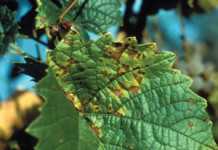Pest Of The Month: Downy Mildew

Identification
All plant parts can become infected with downy mildew. Leaf symptoms usually appear on the underside of the leaf as black or dark specks on young leaves. These spots are often irregular in shape and might appear net-like. The upper side of the leaf also will develop dark spots similar in shape and may be accompanied by leaf yellowing.
On older leaves, these spots often will coalescence resulting in larger areas of the leaf blade having large, sunken, tan-colored spots. Early infection on young plants can cause stunting.
On the underside of the leaf spots, a white-grey, downy growth will often be observed with or without the aid of a hand lens, especially when leaves are wet. On mature cabbage, downy mildew can appear as dark sunken spots on the head or wrapper leaves.
Cauliflower curds and broccoli heads can become infected with blackened areas on the outside of the tissue. The infection can become systemic and turn inner curd and stem tissue dark.
Survival And Spread
Cool, wet conditions are conducive for the development of downy mildew. Spore production is greatest from 53°F to 61°F, but occurs to some extent from 39°F to 85°F. When spores contact a wet leaf, they germinate and penetrate the tissue. Under ideal conditions, symptoms occur in three to four days after infection. Under less than ideal conditions, disease development and spread is progressively slower.
Moisture is required for disease development. If temperatures are suitable, the disease will be more severe under overhead irrigation, high rainfall, or heavy dew and fog.
Management Methods
Currently, downy mildew is controlled primarily by fungicides. Protectant fungicides should be applied at least weekly beginning when nighttime temperatures are conducive for sporulation and disease development, and when rain, dew, or irrigation are frequent or heavy.
Some of the newer fungicides are highly effective in controlling the disease but will typically have a limited number of applications. They should be rotated between Fungicide Resistance Action Committee (FRAC) classes to reduce the possibility of resistance and to help lengthen the effective lifespan of these fungicides.
Since favorable weather for disease development might occur at seeding or transplanting time, growers should be prepared to spray at an early stage of crop development. Crop rotation with non-cruciferous crops might be of some benefit. Cruciferous weeds should be controlled as they might serve as a source of spores.










